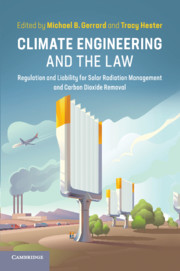23 results
Index
-
- Book:
- Climate Engineering and the Law
- Published online:
- 29 March 2018
- Print publication:
- 12 April 2018, pp 338-350
-
- Chapter
- Export citation
Contents
-
- Book:
- Climate Engineering and the Law
- Published online:
- 29 March 2018
- Print publication:
- 12 April 2018, pp v-v
-
- Chapter
- Export citation
Copyright page
-
- Book:
- Climate Engineering and the Law
- Published online:
- 29 March 2018
- Print publication:
- 12 April 2018, pp iv-iv
-
- Chapter
- Export citation
Preface and Acknowledgments
-
- Book:
- Climate Engineering and the Law
- Published online:
- 29 March 2018
- Print publication:
- 12 April 2018, pp ix-xii
-
- Chapter
- Export citation
1 - Introduction and Overview
-
-
- Book:
- Climate Engineering and the Law
- Published online:
- 29 March 2018
- Print publication:
- 12 April 2018, pp 1-27
-
- Chapter
- Export citation
7 - Conclusions and Recommendations
-
-
- Book:
- Climate Engineering and the Law
- Published online:
- 29 March 2018
- Print publication:
- 12 April 2018, pp 324-337
-
- Chapter
- Export citation
Contributors
-
- Book:
- Climate Engineering and the Law
- Published online:
- 29 March 2018
- Print publication:
- 12 April 2018, pp vi-viii
-
- Chapter
- Export citation

Climate Engineering and the Law
- Regulation and Liability for Solar Radiation Management and Carbon Dioxide Removal
-
- Published online:
- 29 March 2018
- Print publication:
- 12 April 2018
US Federal Climate Change Law in Obama’s Second Term†
-
- Journal:
- Transnational Environmental Law / Volume 3 / Issue 1 / April 2014
- Published online by Cambridge University Press:
- 28 February 2014, pp. 111-125
-
- Article
- Export citation
Will International Law Save Us from Climate Disasters?
-
- Journal:
- Proceedings of the ASIL Annual Meeting / Volume 108 / 2014
- Published online by Cambridge University Press:
- 20 January 2017, pp. 180-183
- Print publication:
- 2014
-
- Article
- Export citation
Preface and Acknowledgments
-
- Book:
- Threatened Island Nations
- Published online:
- 05 February 2013
- Print publication:
- 21 January 2013, pp xvii-xx
-
- Chapter
- Export citation
Part I - Introduction
-
- Book:
- Threatened Island Nations
- Published online:
- 05 February 2013
- Print publication:
- 21 January 2013, pp 1-54
-
- Chapter
- Export citation
Contents
-
- Book:
- Threatened Island Nations
- Published online:
- 05 February 2013
- Print publication:
- 21 January 2013, pp v-viii
-
- Chapter
- Export citation
Part III - Resettlement Protections and Proposed Solutions
-
- Book:
- Threatened Island Nations
- Published online:
- 05 February 2013
- Print publication:
- 21 January 2013, pp 193-406
-
- Chapter
- Export citation
1 - Overview
- from Part I - Introduction
-
-
- Book:
- Threatened Island Nations
- Published online:
- 05 February 2013
- Print publication:
- 21 January 2013, pp 3-14
-
- Chapter
- Export citation
Part IV - Establishing Accountability
-
- Book:
- Threatened Island Nations
- Published online:
- 05 February 2013
- Print publication:
- 21 January 2013, pp 407-626
-
- Chapter
- Export citation
Index
-
- Book:
- Threatened Island Nations
- Published online:
- 05 February 2013
- Print publication:
- 21 January 2013, pp 627-639
-
- Chapter
- Export citation
Threatened Island Nations - Half title page
-
- Book:
- Threatened Island Nations
- Published online:
- 05 February 2013
- Print publication:
- 21 January 2013, pp i-ii
-
- Chapter
- Export citation
Copyright page
-
- Book:
- Threatened Island Nations
- Published online:
- 05 February 2013
- Print publication:
- 21 January 2013, pp iv-iv
-
- Chapter
- Export citation
Threatened Island Nations - Title page
-
-
- Book:
- Threatened Island Nations
- Published online:
- 05 February 2013
- Print publication:
- 21 January 2013, pp iii-iii
-
- Chapter
- Export citation

